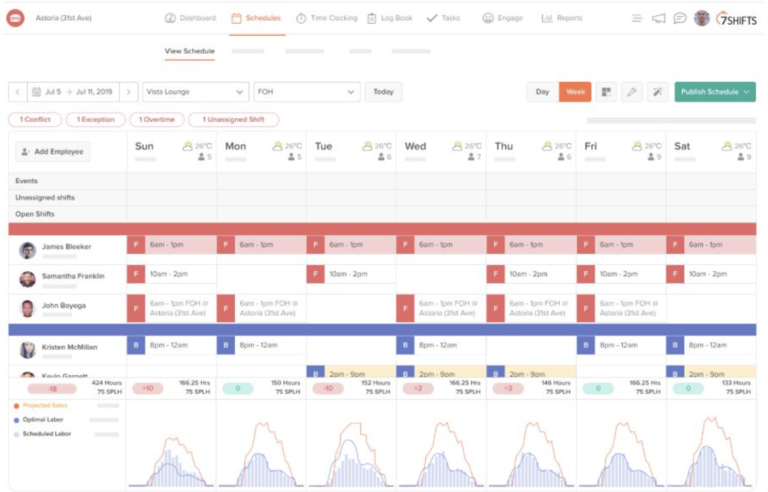
Imagine an up-and-coming chain that’s just expanded from its original location to several more across the area. This growth brings exciting new business opportunities and a sense of accomplishment, but also some real challenges—like scheduling.
Perfecting the scheduling process is crucial as a multi-location restaurant. It’s about striking a balance where the pace is steady enough to keep your teams working across all locations without being overwhelmed, all while maintaining strong customer service across every location.
This guide explores the various challenges that multi-unit restaurants face with employee scheduling and provides guidance on how it can be done efficiently. Let’s dive right in.

Importance of Effective Multi-Location Employee Scheduling for Restaurants
As restaurants expand to multiple locations, the complexity of operations greatly increases. Managing more employees across more locations and ensuring a consistent customer experience across various sites makes scheduling particularly challenging.
Effectively scheduling staff then becomes a critical component of managing this complexity and maintaining smooth operations. If scheduling is set up properly and efficiently, it ensures that each location is properly staffed to meet customer demand while labor costs are kept in check.
Take, for example, a restaurant that expands from one to several locations. If each location manages its scheduling independently without a coordinated strategy, there might be some real discrepancies in service across the locations. One location might be perpetually understaffed during its dinner rushes, leading to long wait times, while another might be overstaffed during its slow afternoon shifts. These misalignments can result in a loss of sales at one location and wasted labor costs at another, not to mention poor customer reviews which damage the restaurant’s brand.
Therefore, efficient scheduling that adapts to the unique demands of each location becomes incredibly important. It ensures that service quality across all outlets is consistent and keeps employee satisfaction high by providing stable, predictable work schedules. This operational efficiency ultimately keeps a restaurant’s brand strong while driving profitability.
Problems With Multi-Location Employee Scheduling
Managing Labor Costs & Staffing Needs
In multi-location restaurant operations, one of the biggest challenges is managing labor costs while meeting staff level needs. With multiple locations, it becomes more difficult to know proper staffing levels for each restaurant.
Overstaffing can lead to high labor costs without the needed revenue, while understaffing can hurt service quality and sales. Effective scheduling requires accurate forecasting of business volume across the locations to determine the right number of staff for each shift and location.
Cross-Location Scheduling Complexities
Handling scheduling across multiple locations adds a layer of complexity. If employees are able to work at multiple locations, the complexity grows even more.
Managers must coordinate employee shifts and account for flexibility, all while considering varying demand and operational nuances of each site. This often requires a centralized scheduling system that can manage multiple inputs and synchronize staffing needs across all the locations.
Communication Breakdowns
Effective communication is crucial in multi-location operations where miscommunications about schedules can lead to operational chaos and employee dissatisfaction. It’s important to have centralized channels of communication that ensure all employees are informed of their schedules in a timely manner and can easily access shift changes or updates.
Compliance with Labor Laws
Each state or even city may have different labor laws that affect how scheduling should be handled. These can include regulations on minimum shift durations, rest periods, overtime, and more.
A restaurant with locations in multiple jurisdictions needs to be compliant to the labor laws of each location so they can avoid legal issues and financial penalties. An automated scheduling system that adapts to comply with local laws can make the process smoother.
Time and Attendance Tracking Challenges
Tracking time and attendance accurately across multiple locations can be a complex task without the right tools. Different locations may use different methods, like digital time clocks or manual timesheets, leading to inconsistencies and potential errors in payroll processing. These discrepancies can make scheduling mishaps more frequent which negatively impacts employee morale and customer service.
Implementing a unified time-tracking system that’s accessible across all locations can help avoid these issues.
Siloed Information and Systems
Sometimes, different locations of the same restaurant chain might use different systems for scheduling, HR, and payroll. This siloed approach can lead to inefficiencies and errors in data management and also makes it challenging to analyze performance across the restaurant portfolio.
Centralizing these systems not only simplifies the management process but also ensures data consistency for accurate analyses across all the locations.
Strategies for Effective Multi-Location Employee Scheduling
Implement one consistent scheduling tool
If a restaurant is using multiple different scheduling tools across locations, there are bound to be problems. And so the first step to effectively scheduling across locations is to implement a single, centralized scheduling tool. This tool should be capable of handling the specific needs of a multi-location operation, such as different time zones, compliance with local labor laws, and varying peak hours.
A consistent tool simplifies the process of scheduling and communicating schedules to employees, while ensuring that all managers are on the same page. This tool will also reduce scheduling errors and mishaps.
Consult this list for the best software vendors providing multi-location scheduling platforms.

Keep the communication method consistent
When schedules are communicated by different methods across locations, things can get confusing very quickly. To avoid miscommunication, restaurants should standardize the communication methods used for discussing and disseminating schedules across all their locations.
The cleanest way to do this is by using scheduling software that has a dedicated app for managers and employees to use. These apps can be used to make schedules available to all employees instantly and often include messaging features where changes and updates can be discussed. Using this type of single, consistent method helps ensure that all employees receive updates in real time and can easily access their schedules. There’s no need to worry that certain employees at certain locations are missing out on important information.
Use forecasting to estimate staffing demand
The ability to accurately forecast staffing needs is vital for efficient scheduling, and this process becomes even more complex as a restaurant adds locations to its portfolio.
There are various software platforms that can help here. These tools use historical sales and traffic data to predict future demand and adjust recommended staffing levels accordingly. These features are a game-changer for multi-location restaurants since they help central management have a data-driven way of knowing optimal staff levels across each location.
Give employees self-service tools
Providing employees with self-service tools streamlines the scheduling process for multi-unit restaurants. These tools allow employees to independently manage their work schedules, including viewing their upcoming shifts, requesting time off, and initiating shift swaps. This level of autonomy reduces the administrative burden on managers and lets them spend less time on scheduling logistics.
Give employees flexibility to work across locations
Allowing employees the flexibility to work across different locations can help balance staffing needs more effectively by enabling the business to deploy staff where they’re needed most. This flexibility can be particularly beneficial during unexpected peaks in demand or staff shortages.
Having this policy also allows employees to pick up additional shifts if they want, which can be a boost to employee morale.

Allow shift trading
Shift trading is a useful feature in scheduling software that allows employees to swap shifts among themselves, subject to approval by a manager.
This flexibility helps ensure that shifts are covered without additional administrative overhead, and it empowers employees to manage their schedules in a way that suits their personal needs.
Delegate the schedule management responsibility
Another important strategy is to delegate the scheduling process to local managers. These managers are often more knowledgeable about the specific nuances of their locations than central management. Because of this familiarity, they’re capable of creating efficient schedules that handle the specific location’s needs. And by giving individual managers this responsibility, the strain on central management can be reduced so that they can focus on other, more strategic business objectives.
The local managers are also likely to feel more responsibility towards their location and are more likely to be bought into its success when they’re given scheduling responsibility.